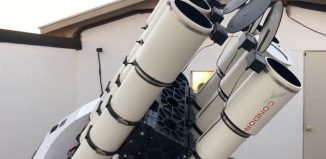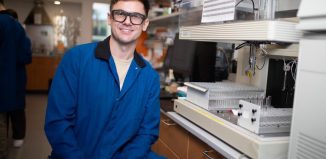BNL systems biologist Sergei Maslov works on KBase
Comparing bacteria’s genes and computer code brought about some scientific surprises
A computational systems biologist, Sergei Maslov recently showed what makes some pieces of computer code critically important to computer systems, the same way certain genes are common and important among bacteria.
“I was working with Linux, which has real similarities with bacteria,” said Maslov, who is a computational biology group leader at the Department of Biosciences at Brookhaven National Laboratory and an external faculty member at Stony Brook. Engineers can “reuse packages created by other engineers, who could be on another continent. It’s a complex interdependency.”
The most frequently used parts are also among the most functionally important ones. Scientists can measure their importance by looking at how many other components depend on them for their operation.
“I was rather shocked by how much is similar” when comparing bacterial genes and computer codes, he said. His results were recently published in the Proceedings of the National Academy of Sciences.
As a systems biologist, Maslov typically works with large amounts of data to make sense of patterns.
“The models I create explain the real world around us. I am very interested in complex networks,” he said. “The first challenge is to get data describing those networks.”
Fortunately, he said, the amount of publicly available data has grown enormously over the last two decades. Indeed, in his study, Maslov looked at over 2 million Linux computers and 500 bacterial species.
Maslov is one of four principal investigators in a large Department of Energy-sponsored project called KBase.
The project, which started a year and a half ago, includes researchers from a wide range of institutions. Maslov leads the group of scientists based at BNL, Cold Spring Harbor Laboratory and Yale.
One of the goals of KBase is to provide a “solid platform that supports predictive biology in a framework that does not require users to learn separate systems to formulate and answer questions spanning a variety of topics in systems biology research,” according to the KBase website.
The application of that predictive research includes handling biological problems in energy and the environment.
In addition to his work with KBase, Maslov has looked at stock price fluctuations, Internet connectivity data, World Wide Web pages, hyperlinks and many others.
He is currently analyzing food webs by using data in KBase that describes microbial communities and uses network analysis tools to make sense of microbe-microbe and plant-microbe interactions.
“I view food webs as a network of interacting objects,” he said. “You can study all the individual microbes in a food web very well, but still not understand how they interact.”
He looks at the pattern of connections among species, to determine which species might be more important. Long-term, he said he wants to understand how certain perturbations — or changes — will cascade down food webs.
“We want to understand which perturbations lead to minor changes and which will lead to large-scale systemwide changes,” he said.
Maslov said the biggest lesson he’s learned from studying the patterns in evolution is that “if you want to design software or any other complex system, make it evolvable. Make sure it doesn’t become too rigid.”
Maslov has lived in many towns since he came to Long Island two decades ago, including in Stony Brook, Sound Beach, and Dix Hills. Indeed, when he resided in Dix Hills, he lived in saxophone great John Coltrane’s house, which is now being turned into a museum.
Maslov’s wife Olga Maslova, a costume designer, is working on sets and costumes for an opera in Boston. Maslova left for the first meeting with producers on the day of the marathon, but was on the Long Island ferry during the attack.
The couple lives in Shoreham with their 10-year-old son Leo and their 6-year-old Alexander.
Maslov grew up in Moscow and appreciates the proximity of Long Island to the City.
As for his research, “We allow the people who do experiments on organisms to recommend particular genes they should pay attention to, maybe provide some guidance on how best to optimize a plant to survive in drought or good soil conditions. We organize the data and allow researchers to work with it.






